Project Fair 2024
The Project Fair took place in the Culture and Convention Center of METU on June 13th, 2024.
Program
- 10:00 Opening Ceremony (CCC Kemal Kurdaş Hall)
- 10:30–12:30 Exhibition (1st session, CCC Exhibition Hall)
- 12:30–13:30 Lunch Break
- 13:30–15:30 Exhibition (2nd session, CCC Exhibition Hall)
- 15:30 Exhibition Award Ceremony + Cocktail
- 16:30 Documentary (CCC Kemal Kurdaş Hall)
Below, you can find information about the projects of all groups.
You can access detailed information about a specific group (their abstract, video, and poster) by clicking on the group’s name in the table below.
ADSEC

Advisor: Assoc. Prof. Elif Vural
By allowing parents to track their baby’s wellbeing in real time, ADSEC Smart Baby Monitoring project aims to ease their worries. The wearable bracelet, parent interface mobile app, and master unit make up the three main components of the system. Master Unit is responsible from movement tracking with computer vision, voice recognition, dB measurement and lullaby playing while the bracelet is responsible from the bpm measurement and temperature measurement. With intercommunication of these three units, product offers parents to track of:
Movement detection
Voice recognition
Temperature measurement
Crying Status Detection and Lullaby Playing
Sleep Awake Condition
ANEBIT

Advisor: Prof. Dr. Ali Özgür Yılmaz
ANEBIT’s latest innovation, the Autonomous Unmanned Ground Vehicle (UGV), leverages cutting-edge 2D LiDAR sensor technology to autonomously navigate various environments. This smart robot vehicle is designed to enhance operational efficiencies in potentially hazardous settings such as warehouses, factories, and hospitals, performing tasks that are typically repetitive or dangerous for humans. By generating precise 3D maps of its surroundings, the UGV can move accurately to designated locations, avoiding obstacles and reducing operational risks. Our diverse team of experts is perfecting the robot’s navigation systems, user interfaces, and durability to ensure it meets industry needs while remaining accessible to all users, regardless of their technical expertise.
Aperture Laboratories

Advisor: Assoc. Prof. Elif Vural
Our project focuses on the development of an Autonomous Unmanned Ground Vehicle (UGV) called GLaDOS, designed to enhance indoor navigation and mapping capabilities. This UGV utilizes 2D LIDAR sensor to construct 3D map of an indoor environment and autonomously navigate to target point. It features various subsystems for precise localization, obstacle avoidance, and path planning. The main aim is to deliver a cost-effective and adaptable solution for autonomous indoor navigation, meeting the growing demand for such technology in various applications.
Baritone Dynamics

Advisor: Assoc. Prof. Yeşim Serinağaoğlu Doğrusöz
The Direction Finding Vehicle (DFV) project introduces a ground-based platform tailored for single antenna direction finding, emphasizing autonomy and advanced tracking capabilities. Engineered to operate in signal-jammed environments, the DFV incorporates robust anti-hopping measures, ensuring seamless operation across various frequencies. It efficiently reaches emitters in less than 30 seconds, enhancing operational efficiency and reliability. Operating within the 2.8-3.8 GHz frequency range, the DFV offers versatile solutions for precise direction finding and tracking, achieving remarkable initial direction determination with an accuracy of ±15◦ for detected emitters. Additionally, the DFV boasts rapid adaptability, transitioning between frequency changes in less than 5 milliseconds for optimal performance in dynamic environments.
BEMAC
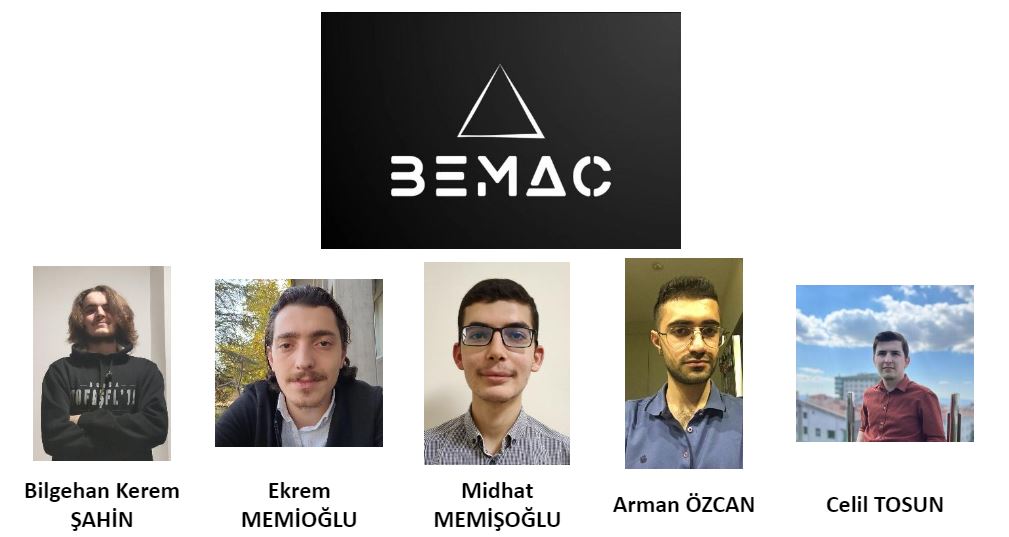
Advisor: Assoc. Prof. Yeşim Serinağaoğlu Doğrusöz
The BEMAC Smart Baby Monitor project aims to enhance infant monitoring and parent-child communication with cutting-edge features. The monitor integrates autonomous crying and word detection, temperature and movement monitoring, and long-distance communication. Key components include a wristband module for temperature tracking, a torso module for movement and sleep-awake detection, and a voice module for two-way communication and lullabies. The system utilizes machine learning for voice recognition and GSM technology for communication, ensuring parents can interact with their baby from any distance. The device prioritizes safety with hypoallergenic materials and secure electronic components. This innovative solution addresses the limitations of traditional baby monitors, providing parents with real-time, comprehensive information about their infant’s well-being.
BeyondTech

Advisor: Assoc. Prof. Ayşe Melda Yüksel Turgut
The “Long Thin Hauler” project, developed by BeyondTech, aims to design and produce a specialized vehicle capable of operating within a constrained 3m x 3m area. This innovative vehicle is engineered to navigate from a randomly assigned starting position within the area to a designated parking spot located along the edge. The project integrates advanced vision and control algorithms, reliable sensor technology, and precise mechanical design to enable the vehicle to achieve efficient and accurate movement. The Long Thin Hauler’s ability to maneuver in tight spaces has significant implications for applications in warehouse logistics, automated parking systems, and industrial automation. BeyondTech’s development showcases the potential for enhanced operational efficiency and spatial management in various industrial settings.
Big Bang Electronics

Advisor: Asst. Prof. Eren Balevi
Big Bang Electronics is a project group of six talented and dedicated students: Nida Aykut, Emirhan Koca, Ali Bora Metin, Vusal Novruzov, Engin Berk Özbay, and Can Taş. Under the guidance of advisor Eren Balevi, the team embarked on an innovative project to develop a state-of-the-art electronics system aimed at revolutionizing the field of wearable technology. The project focuses on designing and implementing a smart wearable device that integrates seamlessly with the Internet of Things (IoT) ecosystem. The device is capable of real-time health monitoring, environmental sensing, and seamless communication with other smart devices. The core of our system leverages advanced microprocessors, efficient power management techniques, and robust communication protocols to ensure reliability and longevity.The project also involved rigorous testing and optimization to ensure that our device meets the highest standards of performance and user satisfaction.
DINOCO SLAM

Advisor: Prof. Dr. Ali Özgür Yılmaz
Dinoco-SLAM is a pioneering company dedicated to enhancing the capabilities of unmanned ground vehicles (UGVs) through innovative autonomous navigation and mapping technologies. At the heart of our endeavors is the development of an advanced UGV capable of performing accurate 3D mapping using a 2D LIDAR sensor. This technology enables the vehicle to navigate complex environments autonomously, while avoiding both static and dynamic obstacles effectively. Our UGV project integrates sophisticated subsystems for mapping, localization, and navigation, which are meticulously designed to operate cohesively to achieve high precision and reliability in indoor settings. Dinoco-SLAM’s mission is to drive forward the fields of autonomous transportation, surveillance, and environmental monitoring by delivering robust UGV solutions that can operate safely and efficiently across various industries. Our commitment to innovation and quality reflects our vision to be a leader in autonomous system technologies, pushing the boundaries of what UGVs can achieve in real-world applications.
EE-Bebek
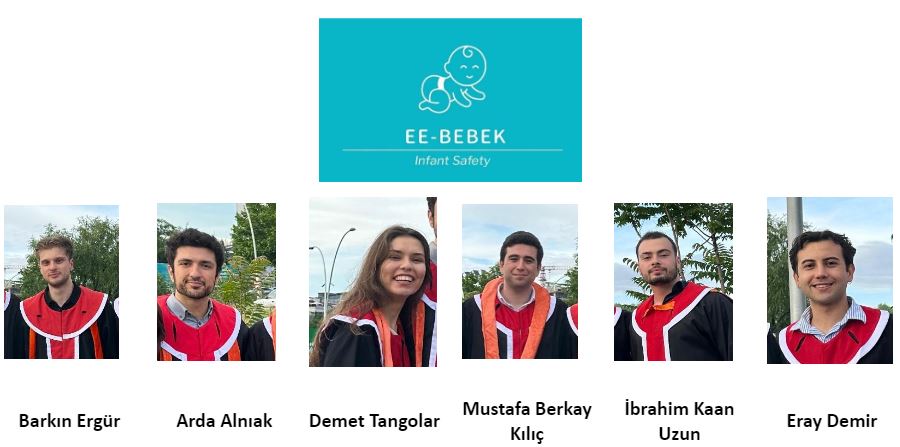
Advisor: Assoc. Prof. Yeşim Serinağaoğlu Doğrusöz
The demanding nature of baby care, especially in monitoring sleep-awake patterns, temperature fluctuations, movements, and vocal cues, requires a thoughtful and comprehensive solution. EE-Bebek’s Smart Baby Monitor is designed to simplify these challenges. It provides parents a reliable way to monitor and interact with their baby in realtime, easing stress and uncertainty. The goal of this product is to make baby care easier by addressing the specific challenges parents face. With its user-friendly and advanced technology, EE-Bebek helps parents confidently manage the complexities of infant care.
ElectroBolt

Advisor: Assoc. Prof. Ayşe Melda Yüksel Turgut
ElectroBolt stands as a symbol of commitment to high-quality, environmentally friendly solutions. Our mission is to deliver safe, user-friendly, and intelligent solutions, prioritizing user experience through advanced technology integration. As ElectroBolt, we introduce the Long Thin Hauler, our autonomous parking solution tailored for crowded urban environments. The dimensions of our vehicle are 10 cm wide, 50 cm long, and 20 cm high. All components and wires, excluding the batteries and sensors, are placed within the chassis to protect both the cables and the surrounding environment. This advanced vehicle identifies and maneuvers into parking spots within a 3×3 m² area, ensuring efficiency and safety. Utilizing LiDAR for parking spot detection and path planning, it features wireless communication optimized through a metal-covered tube.
ELECTRON ELITE
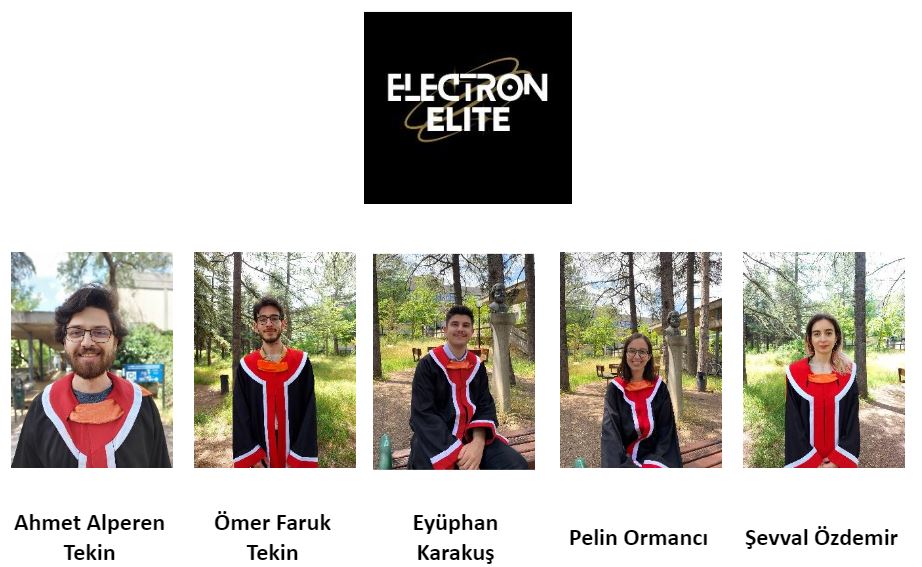
Advisor: Assoc. Prof. Elif Vural
The Smart Baby Monitor is designed to assist caregivers in providing healthier and safer environments for children. It enables parents to track vital metrics, including temperature, movement, and sleep-awake state. Utilizing advanced machine learning algorithms, the monitor can detect early speech, such as “mama” and “dada,” and identify crying, promptly notifying parents. Additionally, it facilitates two-way communication between the baby and parents. The accompanying mobile application allows parents to easily access and monitor these vital signs, ensuring comprehensive and user-friendly oversight of their child’s well-being.
Electrowizards

Advisor: Assoc. Prof. Ayşe Melda Yüksel Turgut
We are Electrowizards, and our product is an autonomously parking long thin hauler. Our company is aiming to address the critical issue of parking in crowded urban environments. Our design features an autonomous ground vehicle capable of identifying parking spots and maneuvering into them without the need for backward movements, ensuring efficiency and safety. Utilizing advanced computer vision and object detection techniques for parking lot detection, the vehicle employs a differential drive system for precise navigation. Wireless communication between sensors and actuators is optimized within a metallic tube, enhancing the system’s reliability. This project not only aims to improve urban traffic flow and reduce greenhouse gas emissions but also provides a user-friendly solution for drivers, particularly benefiting those with disabilities. The innovative design and successful test results underscore the project’s potential to revolutionize autonomous parking technology.
FINISH LINE
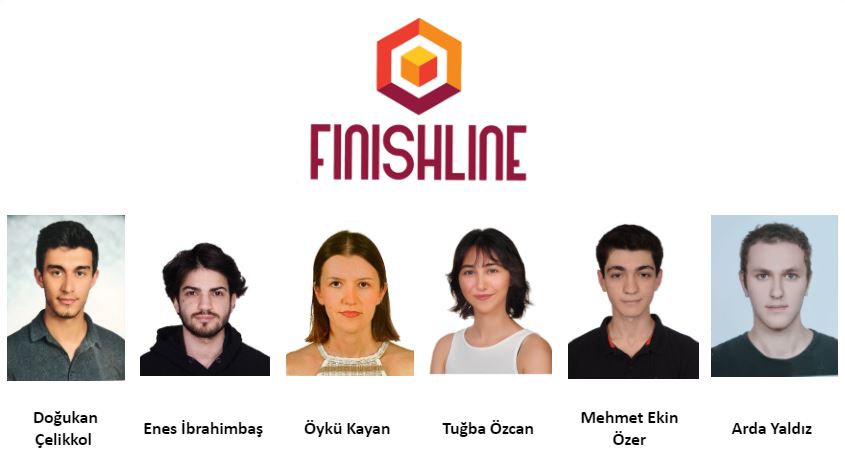
Advisor: Asst. Prof. Ahmet Cemal Durgun
The Finish Line smart baby monitor project aims to redefine traditional baby monitoring with advanced technologies. This innovative product provides parents with real-time insights into their baby’s environment, health, and development through three main components: the camera unit, wearable temperature unit, and monitoring unit. The camera unit, equipped with a camera and microphone, streams live video and processes sound data locally, transmitting relevant information to the monitoring unit. The wearable temperature unit continuously monitors the baby’s body temperature, seamlessly relaying updates without causing discomfort. The monitoring unit acts as the central hub, amalgamating data from the camera and temperature units. Utilizing advanced algorithms, it identifies movement and sleep-wake patterns, ensuring prompt alerts for parents. The monitoring unit also features a touchscreen display and facilitates two-way communication, enabling parents to interact with their baby remotely. This project addresses several engineering challenges, including sensitive algorithms for cry recognition, complex audio processing, and precise sensor and camera technologies. Comprehensive testing has shown high accuracy and reliability, ensuring seamless connectivity and efficient monitoring, providing a state-of-the-art solution for modern parenting.
Huge Electronics
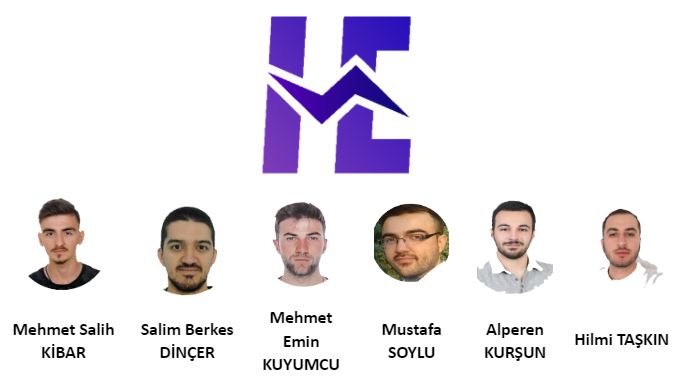
Advisor: Assoc. Prof. Elif Vural
Autonomous systems have transformed industries and daily life, offering innovative solutions to various challenges. These systems, including self-driving cars, cleaning robots, unmanned marine vehicles, and drones, rely on advanced technologies for perception, planning, and control. HUGE Electronics focuses on developing an Autonomous Unmanned Ground Vehicle (UGV) for indoor environments, incorporating state-of-the-art robotics, computer vision, and sensor technology. The UGV is equipped with features designed to enhance its capabilities, reflecting the latest advancements in autonomous navigation and environment perception. This device scans the room via 2D LiDAR and obtains a 3D mapping of the room. Then, the device’s localization subsystem detects the exact position of the device inside the room by a pre-estimated error margin. At the last step, UGV goes from one point to another selected point by choosing a regular path.
Infant Monitoring Devices
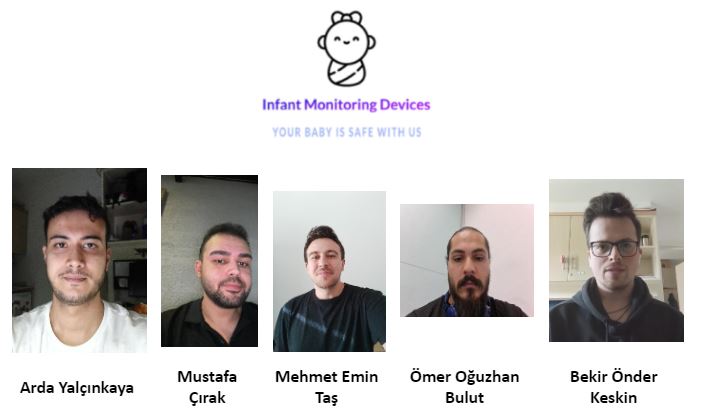
Advisor: Prof. Dr. Ali Özgür Yılmaz
The Infant Monitoring Devices team’s latest innovation, the Smart Baby Monitor, ensures the safety and well-being of infants with advanced sensor technology and wireless communication. This device monitors the baby’s body temperature with an error margin of less than 1°C and detects crying within 10 seconds. It also tracks body movements with a minimum displacement of 20 cm within 1 second, identifies sleep or awake states, and recognizes specific words like “mama” and “papa” with high precision and recall rates. The monitor includes a sound output feature for parental interaction. Designed for comfort, the system uses wireless communication and features small, soft wearable parts to avoid disturbing the baby. Our team is dedicated to optimizing this innovative solution to provide peace of mind for parents and optimal care for infants.
IngenTech

Advisor: Prof. Dr. Ali Özgür Yılmaz
In this project, we explore the development of a basic autonomous unmanned ground vehicle (UGV) system designed for indoor navigation, equipped solely with a 2D LiDAR sensor. The UGV generates a detailed 3D map of its environment, capturing static objects through human-guided movement. This map allows for manual labeling of regions, enabling the UGV to autonomously navigate to specified target areas without further manual intervention.
Our system achieves precise localization using only the LiDAR-generated map and effectively avoids static obstacles, negative obstacles like stairways, and dynamic obstacles encountered during movement. The compact design ensures the device’s height remains under 30 cm, enhancing its versatility in various indoor settings. Additionally, the UGV can potentially extend its operational capabilities to outdoor environments, offering a robust and adaptable solution for autonomous navigation. A user-friendly interface facilitates easy input of target locations, streamlining the interaction with the UGV system.
KALMAN

Advisor: Assoc. Prof. Yeşim Serinağaoğlu Doğrusöz
The Direction Finding Vehicle Project is about a fully autonomous mobile unit equipped with RF sensing electronics. Its objective is to detect and hit an RF broadcasting mobile target within 3-meter radius in azimuth direction. The vehicle designed by KALMAN carries out the target-hitting operation effectively with its accurate navigation, robust design and powerful signal sensing capability. It can hit a stationary target in under seven seconds, detect frequency hopping up to 200 hops per second, hit mobile targets moving under 0.7 meters per second in less than 20 seconds and deliver distance information accurately between 1-3 meters.
Kolaydı

Advisor: Asst. Prof. Eren Balevi
This video highlights each module of the project through real-life footage and user interface demonstrations. First, it features the robot with its rotating lidar generating a 3D scan. Next, the mapping stage is displayed from multiple viewpoints. Following the mapping, the video showcases the motion planning of the robot as it navigates the generated path. This segment also demonstrates the localization algorithm, illustrating how the current scan aligns with the map on the user interface.
Peer Gadgets

Advisor: Asst. Prof. Ahmet Cemal Durgun
Ad hoc communication system for disaster relief project creates a medium for low-cost search and rescue operations with limited communication resources. The system consists of a totat of four units, 3 of them being mobile and 1 of them is a stationary base. Units can communicate with each other over directional infrared LED’s. This communication has a range of 60 cm and can be completed under 250ms. The mobile units can find the target tile, marked with an RFID card, then report it to the base and gather around its adjacent tiles to simulate a rescue scenario. All this operation can be done under 90 seconds. Mobile units discover a 64-tile area autonomously and can generate their own paths to discover the portion of this area assigned to them.
Peter

Advisor: Asst. Prof. Ahmet Cemal Durgun
Our product’s name is Peter Parker. The aim is to have a long-thin vehicle with 2 units, front and rear, which can park itself in under 1 minute, starting from a random position. The rear unit only has actuators, and the front unit only has sensors. These units have a 30 cm separation and communicate with WiFi through the metal-covered tube of 50 cm. The vehicle’s width is 10 cm, and the parking area is 15 cm wide. We also have the constraint of actuating the vehicle only in forward direction. The vehicle only has a camera and 2 line sensors as sensory units, and localization is established with April Tags.
Pineapple

Advisor: Asst. Prof. Eren Balevi
In the video, after showing all the modules on the screen, we first show the movement detection module. Afterwards, we show the accuracy of the temperature module by using a temperature measuring device. We then play a baby crying sound, baby saying ‘mama’ sound, baby saying ‘dada’ sound and a cat meowing sound and showcase the results of the voice recognition modules on the display. Finally, we show the communication modules by first showing the parent unit transmitting sound to the baby unit and then showing the baby unit transmitting sound to the parent unit. We conclude the video by sharing the link to our sleep awake detection module and with a picture of our group.
SIGHT

Advisor: Assoc. Prof. Elif Vural
SIGHT is a company dedicated to developing ad hoc communication systems, particularly in the realm of disaster relief. Our commitment to accuracy, efficiency, and adaptability underscores our dedication to making a meaningful difference in times of adversity.
Our project comprises three mobile units, a base unit, and a designated 9×9 search area and randomized obstacles. Our mobile units are designed to identify targets using RFID technology and transmit accurate location data to the base unit through electrically rotating infrared communication. This transmission enables the base unit to disseminate vital information to all mobile units, ensuring their swift convergence around the target. Additionally, our project includes advanced collision avoidance, achieved through communication between the mobile units and the robots’ path planning systems. These features enable the robots to navigate complex environments safely and efficiently, avoiding obstacles while optimizing their routes. This advanced technology ensures that our mobile units can operate autonomously and effectively, further enhancing the overall disaster relief efforts. Moreover, a graphical user interface is created to display the positions and statuses of the mobile units within the grid.
Sinan Engine

Advisor: Asst. Prof. Eren Balevi
The Smart Baby Monitoring project by Sinan Engine aims to address the critical concerns of parents by providing real-time tracking of their baby’s well-being. The system comprises three main units: a cradle unit, a wearable leg patch, and a parent interface. The cradle unit, equipped with a Raspberry Pi, includes ultrasonic sensors, a microphone, and a speaker to detect movements and sounds, alerting parents accordingly. The wearable leg patch monitors the baby’s temperature and movements. The parent interface offers live notifications and two-way communication. The project ensures high detection accuracy and seamless wireless communication, enhancing the safety and comfort of both the baby and the parents.
SixByteLabs

Advisor: Asst. Prof. Eren Balevi
Drivers are a widespread occupation today, with the majority of drivers working in large vehicles (e.g. trucks and buses). It is a well-known fact that these people face significant problems in the course of their work, problems that perhaps none of us can see or recognize. One of them is the difficulty in parking these large vehicles, where not every part of the vehicle can be controlled by the human eye. So, this is a serious problem and there is a very important need for the vehicle to automatically find the parking space and park there safely.
Smooth Operator

Advisor: Asst. Prof. Ahmet Cemal Durgun
Smooth Operator designed a long, forward-motion-only, rear-wheel-drive land vehicle capable of automatically parking itself in a designated spot. The vehicle must start at a random position and orientation within a 3m x 3m area and successfully park in the spot within one minute. The parking spot is located just outside the 3m x 3m area.
Spark Industries

Advisor: Assoc. Prof. Ayşe Melda Yüksel Turgut
Spark Industries’s Smart Baby Monitor device is designed to address the challenges parents face in consistently and accurately monitoring their babies well being, especially during sleep. Therefore, our device aims continuous and precise monitoring of an infant’s wellbeing through a comprehensive sensor and detection system. This system encompasses various aspects, including temperature measurement, movement detection, cry detection, word detection, and sleep/awake state detection, each functioning as a distinct subsystem. Collectively, these subsystems provide data inputs forwarded to the communication system. Utilizing a Wi-Fi-based communication system, all gathered information is transmitted to a monitor accessible to the parents. The communication subsystem is crucial as it facilitates the transmission of sensor outputs to the monitoring devices.
Starlight Electronics

Advisor: Assoc. Prof. Ayşe Melda Yüksel Turgut
Starlight Electronics has created a new mobile app that aims to improve road safety by identifying traffic infractions. By using cutting-edge image processing and computer vision technologies, the application detects instances of speeding, running red lights, and unsafe passing by analyzing camera footage in real-time. This project utilizes the latest advancement in automated traffic surveillance, with the goal of decreasing accidents and enforcing traffic regulations with greater efficiency. Starlight Electronics, with a committed team of six experts, is at the forefront of creating innovative solutions that combine advanced technology with practical uses in today’s world.
StarSense Ventures
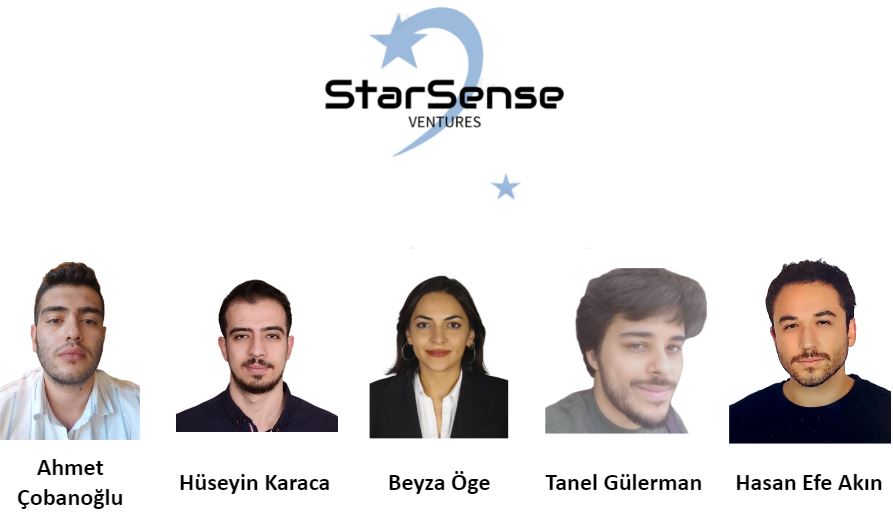
Advisor: Asst. Prof. Ahmet Cemal Durgun
StarSense Ventures introduces the Smart Baby Monitor, a small but powerful device designed for comprehensive infant monitoring at an unmatched cost of about $85 per unit for prototypes. This device ensures real-time monitoring of a baby’s health and environment through a suite of advanced features: precise temperature readings, rapid cry and keyword (mama-papa) detection, movement and sleep-awake status tracking, and so on. The system comprises a wearable end-device for babies, a central controller device (ESP32 S3 Box), and a user-friendly mobile app. Employing state-of-the-art technologies such as the MPU9250 sensor for accurate movement detection, streaming tiny conv net for voice recognition, and MLX90614 for non-contact temperature monitoring, it integrates flawlessly with mobile and cloud platforms for efficient data management and security. This cost-effective, high-quality monitor sets a new standard in the baby care market, offering an affordable and reliable solution for modern parenting needs.
TechBatch

Advisor: Asst. Prof. Eren Balevi
Effective and prompt communication during search and rescue operations is crucial in unavoidable disasters. It serves as the cornerstone for well-coordinated rescue efforts, allowing for efficient allocation of resources, transmission of critical information, and execution of a cohesive response. This rapid communication boosts response efficiency and diminishes the severity of the disaster’s consequences. TechBatch has developed an innovative ad hoc communication system for disaster relief scenarios. The system uses infrared frequencies to simulate a wireless communication environment for a rescue team consisting of three mobile units and a base unit. TechBatch aims to provide eco-friendly project solutions through teamwork, promoting effective communication, and leveraging diverse expertise. Our skilled team specializes in signal processing, communication, electronics, and computer technology, allowing us to innovate and implement cutting-edge solutions.
TechCat

Advisor: Assoc. Prof. Elif Vural
TechCat’s first-ever project “Mobile Application for Traffic Violation Monitoring” enhances road safety by reducing traffic violations through an innovative mobile application. Recognizing traffic accidents as a leading cause of unintentional deaths worldwide, the app leverages advanced signal processing and machine learning techniques to detect and report violations such as speeding, running red lights, and improper overtaking. Utilizing only the smartphone camera, the app processes and transmits data to a cloud database, and detection is made in the main server for efficient management. Over eight months, TechCat implemented major subsystems, including a user-friendly interface via Android Studio, robust server and data transmission with Firebase, and advanced object detection and tracking using YOLOv8 and DeepSORT. The license plate reading subsystem, employing PaddleOCR, ensures high precision under various conditions. Extensive testing optimized video compression, balancing efficiency with accuracy. This project significantly enhances road safety by providing a tool for traffic monitoring and enforcement, aiding traffic management, and encouraging safer driving.
The Usual Engineers (TUE)
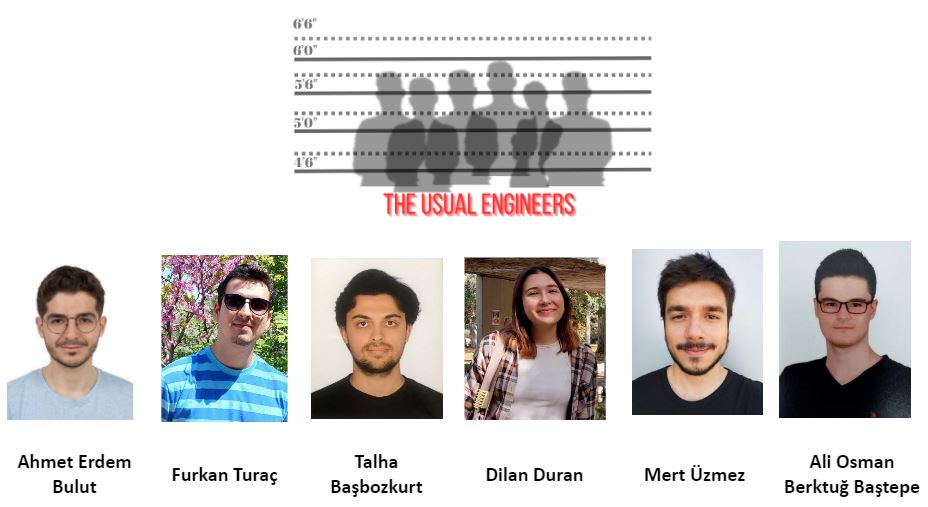
Advisor: Prof. Dr. Ali Özgür Yılmaz
The “Smart Baby Monitor” project by The Usual Engineers aims to address the need for advanced infant monitoring through innovative technology. This device integrates a wearable component, a central monitoring unit (Baby Box), and a mobile application to provide comprehensive real-time insights into a baby’s well-being. Key features include temperature sensing, movement detection, sleep-wake monitoring, and word and crying detection. The wearable device, equipped with sensors, transmits data to the Baby Box, which then communicates with the mobile application. The project successfully implemented and tested all modules, demonstrating effective two-way communication and accurate monitoring of the baby’s status. The Smart Baby Monitor not only enhances parental peace of mind by ensuring their baby’s safety but also has the potential to revolutionize infant care by providing timely alerts and insights, ultimately fostering better health outcomes and stronger parent-child bonds.
UEGroup

Advisor: Assoc. Prof. Yeşim Serinağaoğlu Doğrusöz
UEGroup is a group made up of 6 members, focusing on developing reliable, efficient and cost effective solutions for baby monitoring. Our product BabyGuard measures and relays vital signs of the baby completely wirelessly to the parents using a modern and minimal mobile application they can access on their smartphones. Parents can monitor vital information like sleep awake status, body temperature, movement and crying of their baby determined using our carefully calibrated sensors and algorithms.
Watt’s Up

Advisor: Asst. Prof. Ahmet Cemal Durgun
Watt’s Up is excited to introduce the Smart Baby Monitor Project, a groundbreaking solution designed to give parents peace of mind and confidence. Designing such an advanced project with various engineering concepts creates problems such as precise data collection, clear voice detection, and accuracy while not disturbing the baby. We have a group of dedicated professionals, including RF and hardware engineers, software developers, machine learning experts, and signal processing specialists. The system comprises three main components, arms sleeve unit, control box , and user interface. The control unit includes Raspberry, speakers, motion sensor, two microphones. The wearable arm sleeve unit informs the baby’s temperature and heart rate data to parents. The device for monitoring babies involves overcoming challenges in making sure vital sign measurements are accurate and providing enough power efficiency while keeping continuous monitoring. The user interface provides real-time notifications and two-way communication between parent and the baby, when the baby cried, it commands to play lullabies also. The project ensures high detection accuracy and precision rates, leading to enhance the safety and comfort of both the baby and the parents.

